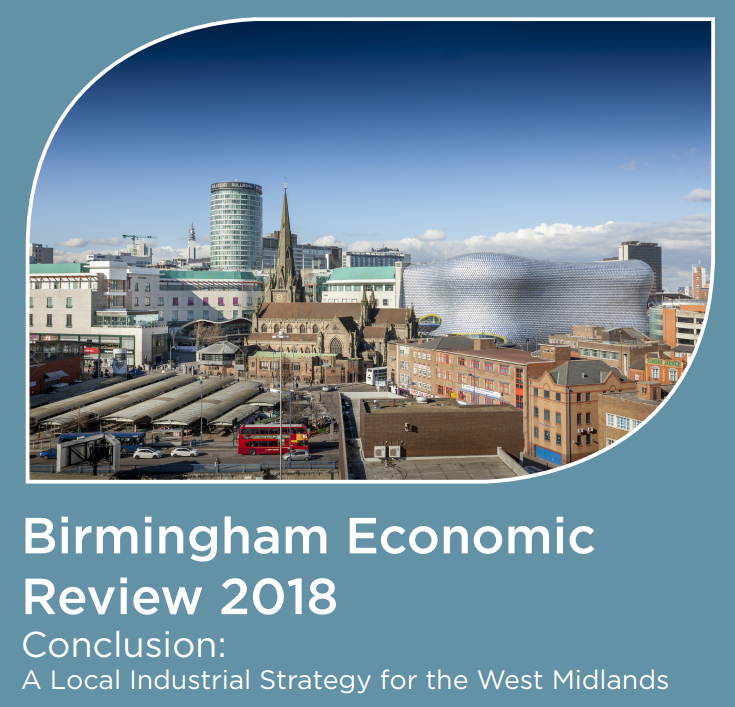 This blog post has been produced to provide insight into the findings of the Birmingham Economic Review.
This blog post has been produced to provide insight into the findings of the Birmingham Economic Review.
The Birmingham Economic Review 2018 is produced by City-REDI, University of Birmingham and the Greater Birmingham Chambers of Commerce, with contributions from the West Midlands Growth Company. It is an in-depth exploration of the economy of England’s second city and is a high-quality resource for organisations seeking to understand Birmingham to inform research, policy or investment decisions.
This post is featured in the full report and report summary here.
In the UK, like many other countries, industrial strategy has been back on the policy agenda since the Great Financial Crisis. We can trace a line in recent Government thinking from Peter Mandelson’s ‘New Industry, New Jobs’, through to ideas developed by Vince Cable and David Willetts in the Coalition, to the Industrial Strategy White Paper published in 2017. Two recurring themes stand out: first, a matrix approach which focuses on key technologies, priority industries and cross-sector measures, and second, an emphasis on ‘place’, especially cities, as key economic sites and as actors that can generate and drive policy forward.
In the current round of policymaking, the West Midlands is one of two so-called ‘trailblazer’ regions that is developing a Local Industrial Strategy (LIS) in partnership with Whitehall – Greater Manchester is the other. This means that West Midlands ideas and experience will help shape policy decisions and outcomes across England in the years to come, especially as the government intends the whole of the country to have an LIS in place by 2020.
Over the last year, What Works Centre for Local Economic Growth has been working with the West Midlands Combined Authority (and other CAs, local authorities and LEPs) to help local decision-makers develop and refine their own local industrial strategies. We recently published a report that draws together our thinking, building on our own comprehensive evidence base, academic insights, and in-depth discussions with partner local and combined authorities, local enterprise partnerships and central government.
 The report contains a wide range of ideas, but here are five to start:
The report contains a wide range of ideas, but here are five to start:
Build on current strengths – but think about how your economy might evolve
Places need to find a balance between fostering new ideas and supporting existing economic activity while working with existing and potential employers. The trade-offs involved in these decisions are illustrated by Luton Borough Council’s £3.2m investment package with local employer Peugeot to help save the town’s Vauxhall van factory.
While this may safeguard the factory’s 1,400 jobs for now, it comes with the opportunity cost of not being able to spend as much on other activities. A good local industrial strategy will help areas understand the trade-offs and prioritise future investment.
Beware expensive economic modelling
In our conversations with local leaders, we’ve heard stories about places spending considerable money on complex economic models, which supposedly predict the future impact of different policies.
But we worry that many of these models are invalid, offering little insight on the likely effect of many policies. Well done, local economic modelling is an important input into strategic planning and industrial strategy-making. But it is one tool among many. We think that higher-level scenario planning is likely more useful in the local industrial strategy decision-making process to structure thinking about the future economy, identifying trends, risks and uncertainties.
Don’t assume that if you build it they will come
It can be tempting for local leaders to focus on grand projects – from new buildings to eye-catching transport schemes – as they offer visible, immediate impact that many longer-term initiatives don’t.
However, these projects often assume demand from firms will follow supply when in many cases the reverse is true.
To mitigate the risks involved in supply-side initiatives, particularly in the case of shiny new buildings, places should ensure that investment builds on existing or potential economic strengths which have been credibly analysed and assessed. Wishful thinking is unlikely to deliver a good return.
 Don’t prefer one sector or employer without wider economic benefits
Don’t prefer one sector or employer without wider economic benefits
If a business or industry is a large part of the local economy, policymakers can be understandably inclined to prefer them in local industrial and other strategies. But it’s important to consider who benefits. Will the intervention only help that firm or sector, or will it have a broader positive effect?
For example, does that large employer in your area train workers who go on to work for other businesses? If the answer is yes there might be a good case to consider support. If not then support is harder to justify, and you might want to consider something more general.
Experiment and evaluate – then share your findings
One of the aims of the local industrial strategy is to find new and improved ways for policy to boost growth. As the government has recognised, this means there is a risk that some projects fail. Places should boldly experiment to find more cost-effective ways to support economic growth.
Embedding thorough evaluation at the heart of policy design from the start will be crucial in assessing the success of these policies. It’s also vital that places share learning with peers so that other areas can benefit from what works and avoid blind alleys in their own policymaking.
The report contains many other suggestions. None of these ideas are brand new, but they should help places properly analyse their local economy, understand where interventions are needed, and consider the best policies to adopt. All these factors will be crucial in delivering local industrial strategies that really tackle the economic challenges and opportunities that places face.
This blog was written by Dr Max Nathan, City-REDI, University of Birmingham and Deputy Director, What Works Centre for Local Economic Growth.
Disclaimer:
The views expressed in this analysis post are those of the authors and not necessarily those of City-REDI or the University of Birmingham.
To sign up for our blog mailing list, please click here.
